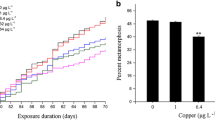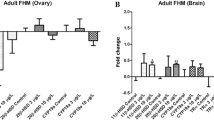Abstract
Nonnutritive sweeteners used in food and beverage products are widespread, persistent aquatic pollutants. Despite this, their impact on aquatic organisms, particularly vertebrates, is not well-studied. Recent findings in rodents suggest sucralose, a chlorinated disaccharide, alters thyroid hormone (TH) metabolism. Because amphibian tadpole metamorphosis is TH-dependent, we hypothesized sucralose may alter signaling for this postembryonic developmental process. The present study used the American bullfrog, Rana (Lithobates) catesbeiana, as a sensitive, environmentally relevant model for testing TH disruption in the absence and presence of thyroxine (T4), a hormone that induces metamorphosis. Premetamorphic R. catesbeiana tadpoles were immersed in 1-, 15-, and 32-mg/L sucralose solutions ± 5 nM (3.9 µg/L) thyroxine (T4) for 48 h. RNA transcripts encoding thyroid hormone receptors alpha and beta (thra and thrb) and TH-induced basic region leucine zipper protein (thibz) were analyzed in four tissues: back skin, liver, olfactory epithelium, and tail fin, using reverse transcription quantitative real-time PCR (RT-qPCR). We found that sucralose altered the expression of fundamental TH-response genes involved in anuran metamorphosis in a tissue- and TH-status dependent manner. As organochlorines induce xenobiotic metabolism, we isolated and characterized three novel R. catesbeiana gene transcripts involved in xenobiotic metabolism: pregnane X receptor (nr1i2), constitutive androstane receptor (nr1i3), and cytochrome p450 3a4 (cyp3a4). We analyzed their expression using RT-qPCR and found evidence of their modulation by sucralose. To our knowledge, these data are the first to show xenobiotic and thyroid-disrupting activities in amphibians and further investigations into cumulative effects of environmental sucralose exposure are warranted.


Similar content being viewed by others
References
Abou-Donia MB, El-Masry EM, Abdel-Rahman AA, McLendon RE, Schiffman SS (2008) Splenda alters gut microflora and increases intestinal P-glycoprotein and cytochrome P-450 in male rats. J Toxicol Environ Health A 71:1415–1429. https://doi.org/10.1080/15287390802328630
Baird IM, Shephard NW, Merritt RJ, Hildick-Smith G (2000) Repeated dose study of sucralose tolerance in human subjects. Food Chem Toxicol 38:123–129. https://doi.org/10.1016/s0278-6915(00)00035-1
Brown DD, Cai L (2007) Amphibian metamorphosis. Dev Biol 306:20–33. https://doi.org/10.1016/j.ydbio.2007.03.021
Cantwell MG, Katz DR, Sullivan J, Kuhn A (2019) Evaluation of the artificial sweetener sucralose as a sanitary wastewater tracer in Narragansett Bay, Rhode Island, USA. Mar Pollut Bull 146:711–717. https://doi.org/10.1016/j.marpolbul.2019.07.036
Crump D, Werry K, Veldhoen N, Van Aggelen G, Helbing CC (2002) Exposure to the herbicide acetochlor alters thyroid hormone-dependent gene expression and metamorphosis in Xenopus laevis. Environ Health Perspect 110:1199–1205. https://doi.org/10.1289/ehp.021101199
Freitas J, Cano P, Craig-Veit C, Goodson ML, Furlow DJ, Murk AJ (2011) Detection of thyroid hormone receptor disruptors by a novel stable in vitro reporter gene assay. Toxicol In Vitro 25:257–266. https://doi.org/10.1016/j.tiv.2010.08.013
Fu K, Wang L, Wei C, Li J, Zhang J, Zhou Z, Liang Y (2020) Sucralose and acesulfame as an indicator of domestic wastewater contamination in Wuhan surface water. Ecotoxicol Environ Saf 189:109980. https://doi.org/10.1016/j.ecoenv.2019.109980
Grimaldi A, Buisine N, Miller T, Shi Y-B, Sachs LM (2013) Mechanisms of thyroid hormone receptor action during development: lessons from amphibian studies. Biochim Biophys Acta BBA Gen Subj 1830:3882–3892. https://doi.org/10.1016/j.bbagen.2012.04.020
Hammond SA, Jackman KW, Partovi SH, Veldhoen N, Helbing CC (2016) Identification of organ-autonomous constituents of the molecular memory conferred by thyroid hormone exposure in cold temperature-arrested metamorphosing Rana (Lithobates) catesbeiana tadpoles. Comp Biochem Physiol Part D Genomics Proteomics 17:58–65. https://doi.org/10.1016/j.cbd.2016.01.002
Hammond SA, Warren RL, Vandervalk BP, Kuçuk E, Khan H, Gibb EA, Pandoh P, Kirk H, Zhao Y, Jones M, Mungall AJ, Coope R, Pleasance S, Moore RA, Holt RA, Round JM, Ohora S, Walle BV, Veldhoen N, Helbing CC, Birol I (2017) The North American bullfrog draft genome provides insight into hormonal regulation of long noncoding RNA. Nat Commun 8:1433. https://doi.org/10.1038/s41467-017-01316-7
Heerema JL, Jackman KW, Miliano RC, Li L, Zaborniak TSM, Veldhoen N, van Aggelen G, Parker WJ, Pyle GG, Helbing CC (2018) Behavioral and molecular analyses of olfaction-mediated avoidance responses of Rana (Lithobates) catesbeiana tadpoles: Sensitivity to thyroid hormones estrogen treated municipal wastewater effluent. Horm Behav 101:85–93. https://doi.org/10.1016/j.yhbeh.2017.09.016
Hofmann PJ, Schomburg L, Köhrle J (2009) Interference of endocrine disrupters with thyroid hormone receptor–dependent transactivation. Toxicol Sci 110:125–137. https://doi.org/10.1093/toxsci/kfp086
Istrate MA, Nussler AK, Eichelbaum M, Burk O (2010) Regulation of CYP3A4 by pregnane X receptor: the role of nuclear receptors competing for response element binding. Biochem Biophys Res Commun 393:688–693. https://doi.org/10.1016/j.bbrc.2010.02.058
Jackman KW, Veldhoen N, Miliano RC, Robert BJ, Li L, Khojasteh A, Zheng X, Zaborniak TSM, van Aggelen G, Lesperance M, Parker WJ, Hall ER, Pyle GG, Helbing CC (2018) Transcriptomics investigation of thyroid hormone disruption in the olfactory system of the Rana [Lithobates] catesbeiana tadpole. Aquat Toxicol 202:46–56. https://doi.org/10.1016/j.aquatox.2018.06.015
Jacobs MN, Nolan GT, Hood SR (2005) Lignans, bacteriocides and organochlorine compounds activate the human pregnane X receptor (PXR). Toxicol Appl Pharmacol 209:123–133. https://doi.org/10.1016/j.taap.2005.03.015
Jones SA, Moore LB, Shenk JL, Wisely GB, Hamilton GA, McKee DD, Tomkinson NCO, LeCluyse EL, Lambert MH, Willson TM, Kliewer SA, Moore JT (2000) The pregnane X receptor: a promiscuous xenobiotic receptor that has diverged during evolution. Mol Endocrinol 14:27–39. https://doi.org/10.1210/mend.14.1.0409
Knight I (1994) The development and applications of sucralose a new high-intensity sweetener. Can J Physiol Pharmacol 72:435–439. https://doi.org/10.1139/y94-063
Kretschmer XC, Baldwin WS (2005) CAR and PXR: Xenosensors of endocrine disrupters? Chem Biol Interact 155:111–128. https://doi.org/10.1016/j.cbi.2005.06.003
Lehmann JM, McKee DD, Watson MA, Willson TM, Moore JT, Kliewer SA (1998) The human orphan nuclear receptor PXR is activated by compounds that regulate CYP3A4 gene expression and cause drug interactions. J Clin Invest 102:1016–1023. https://doi.org/10.1172/JCI3703
Li D, O’Brien JW, Tscharke BJ, Choi PM, Ahmed F, Thompson J, Mueller JF, Sun H, Thomas KV (2021) Trends in artificial sweetener consumption: a 7-year wastewater-based epidemiology study in Queensland, Australia. Sci Total Environ 754:142438. https://doi.org/10.1016/j.scitotenv.2020.142438
Livak KJ, Schmittgen TD (2001) Analysis of relative gene expression data using real-time quantitative PCR and the 2−ΔΔCt method. Methods 25:402–408. https://doi.org/10.1006/meth.2001.1262
Loos R, Gawlik BM, Boettcher K, Locoro G, Contini S, Bidoglio G (2009) Sucralose screening in European surface waters using a solid-phase extraction-liquid chromatography–triple quadrupole mass spectrometry method. J Chromatogr A 1216:1126–1131. https://doi.org/10.1016/j.chroma.2008.12.048
Luo J, Zhang Q, Cao M, Wu L, Cao J, Fang F, Li C, Xue Z, Feng Q (2019) Ecotoxicity and environmental fates of newly recognized contaminants-artificial sweeteners: a review. Sci Total Environ 653:1149–1160. https://doi.org/10.1016/j.scitotenv.2018.10.445
Maher SK, Wojnarowicz P, Ichu T-A, Veldhoen N, Lu L, Lesperance M, Propper CR, Helbing CC (2016) Rethinking the biological relationships of the thyroid hormones L-thyroxine and 3,5,3′-triiodothyronine. Comp Biochem Physiol Part D Genomics Proteomics 18:44–53. https://doi.org/10.1016/j.cbd.2016.04.002
Martínez-Sánchez N, Alvarez CV, Fernø J, Nogueiras R, Diéguez C, López M (2014) Hypothalamic effects of thyroid hormones on metabolism. Best Pract Res Clin Endocrinol Metab 28:703–712. https://doi.org/10.1016/j.beem.2014.04.004
Oppenheimer J, Eaton A, Badruzzaman M, Haghani AW, Jacangelo JG (2011) Occurrence and suitability of sucralose as an indicator compound of wastewater loading to surface waters in urbanized regions. Water Res 45:4019–4027. https://doi.org/10.1016/j.watres.2011.05.014
Pałkowska-Goździk E, Bigos A, Rosołowska-Huszcz D (2018) Type of sweet flavour carrier affects thyroid axis activity in male rats. Eur J Nutr 57:773–782. https://doi.org/10.1007/s00394-016-1367-x
Paul KB, Hedge JM, DeVito MJ, Crofton KM (2010) Short-term exposure to triclosan decreases thyroxine in vivo via upregulation of hepatic catabolism in young Long-Evans rats. Toxicol Sci 113:367–379. https://doi.org/10.1093/toxsci/kfp271
Paul KB, Thompson JT, Simmons SO, Vanden Heuvel JP, Crofton KM (2013) Evidence for triclosan-induced activation of human and rodent xenobiotic nuclear receptors. Toxicol In Vitro 27:2049–2060. https://doi.org/10.1016/j.tiv.2013.07.008
Praveena SM, Cheema MS, Guo H-R (2019) Non-nutritive artificial sweeteners as an emerging contaminant in environment: a global review and risks perspectives. Ecotoxicol Environ Saf 170:699–707. https://doi.org/10.1016/j.ecoenv.2018.12.048
Qatanani M, Zhang J, Moore DD (2005) Role of the constitutive androstane receptor in xenobiotic-induced thyroid hormone metabolism. Endocrinology 146:995–1002. https://doi.org/10.1210/en.2004-1350
Roberts A, Renwick AG, Sims J, Snodin DJ (2000) Sucralose metabolism and pharmacokinetics in man. Food Chem Toxicol 38:31–41. https://doi.org/10.1016/s0278-6915(00)00026-0
Schraplau A, Schewe B, Neuschäfer-Rube F, Ringel S, Neuber C, Kleuser B, Püschel GP (2015) Enhanced thyroid hormone breakdown in hepatocytes by mutual induction of the constitutive androstane receptor (CAR, NR1I3) and arylhydrocarbon receptor by benzo[a]pyrene and phenobarbital. Toxicology 328:21–28. https://doi.org/10.1016/j.tox.2014.12.004
Shi Y-B (2000) Amphibian metamorphosis: from morphology to molecular biology. Wiley-Liss, New York
Spoelstra J, Schiff SL, Brown SJ (2013) Artificial sweeteners in a large Canadian river reflect human consumption in the watershed. PLoS ONE 8:e82706. https://doi.org/10.1371/journal.pone.0082706
Tata JR (2006) Amphibian metamorphosis as a model for the developmental actions of thyroid hormone. Mol Cell Endocrinol 246:10–20. https://doi.org/10.1016/j.mce.2005.11.024
Thambirajah AA, Koide EM, Imbery JJ, Helbing CC (2019) Contaminant and environmental influences on thyroid hormone action in amphibian metamorphosis. Front Endocrinol 10:276. https://doi.org/10.3389/fendo.2019.00276
Veldhoen N, Propper CR, Helbing CC (2014) Enabling comparative gene expression studies of thyroid hormone action through the development of a flexible real-time quantitative PCR assay for use across multiple anuran indicator and sentinel species. Aquat Toxicol 148:162–173. https://doi.org/10.1016/j.aquatox.2014.01.008
Walsh PT, Downie JR, Monaghan P (2016) Factors affecting the overwintering of tadpoles in a temperate amphibian. J Zoology 298:183–190. https://doi.org/10.1111/jzo.12296
Williams GR (2008) Neurodevelopmental and neurophysiological actions of thyroid hormone. J Neuroendocrinol 20:784–794. https://doi.org/10.1111/j.1365-2826.2008.01733.x
Wu M, Qian Y, Boyd JM, Hrudey SE, Le XC, Li X-F (2014) Direct large volume injection ultra-high performance liquid chromatography-tandem mass spectrometry determination of artificial sweeteners sucralose and acesulfame in well water. J Chromatogr A 1359:156–161. https://doi.org/10.1016/j.chroma.2014.07.035
Zoeller RT (2005) Environmental chemicals as thyroid hormone analogues: new studies indicate that thyroid hormone receptors are targets of industrial chemicals? Mol Cell Endocrinol 242:10–15. https://doi.org/10.1016/j.mce.2005.07.006
Acknowledgements
The authors thank Emily Koide, Jessica Round, and Lorissa Corrie for their technical assistance and helpful discussions and Dr. Jun Han at the University of Victoria-Genome BC Proteomics Centre for his mass spectrometry expertise.
Funding
This research was supported by a Natural Sciences and Engineering Research Council (NSERC) Discovery Grant RGPIN-2018-03816 to CCH.
Author information
Authors and Affiliations
Corresponding author
Ethics declarations
Conflict of interest
The authors declare that they have no conflict of interest.
Ethics Approval (Include Appropriate Approvals or Waivers)
Care and use of animals was approved by the University of Victoria Animal Care Committee: Protocols #2015-028 and #2019-025.
Supplementary Information
Below is the link to the electronic supplementary material.
Rights and permissions
About this article
Cite this article
Abbott, E.A., Helbing, C.C. Sucralose Affects Thyroid Hormone Signaling in American Bullfrog [Rana (Lithobates) catesbeiana] Tadpoles. Arch Environ Contam Toxicol 80, 735–744 (2021). https://doi.org/10.1007/s00244-021-00838-y
Received:
Accepted:
Published:
Issue Date:
DOI: https://doi.org/10.1007/s00244-021-00838-y




